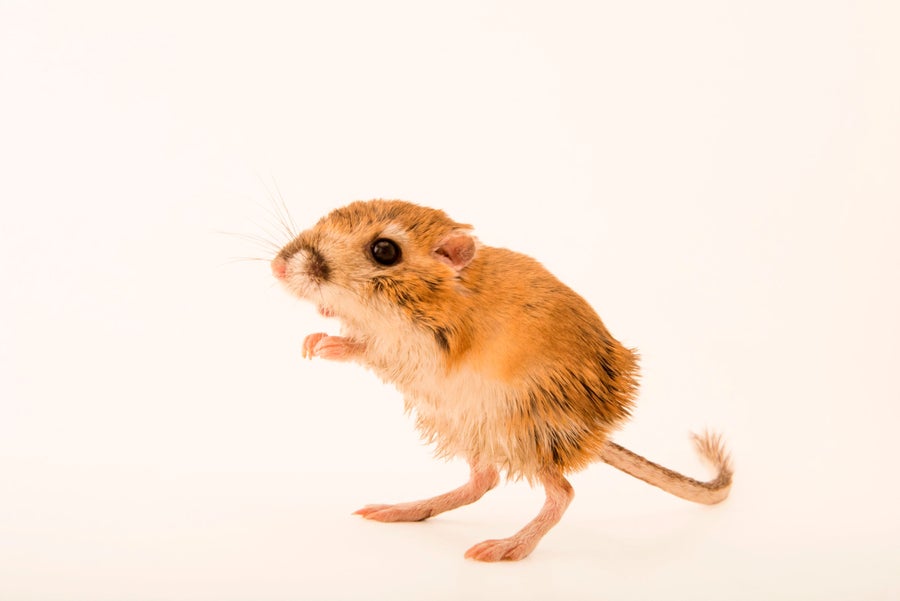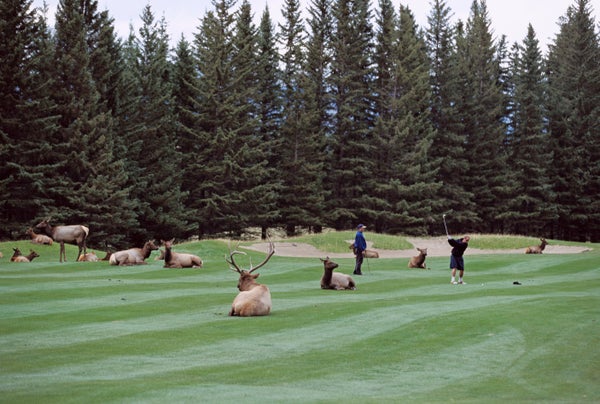The kangaroo rat is a wildlife manager’s nightmare. It is a crucial species in southern California—aerating soils and dispersing native plant seeds. And the adorable, bouncing mouse is popular with the public. But it also has the same taste in real estate as powerful developers, many of its subspecies are endangered and the animals are nearly impossible to relocate. As with many declining critters across the world, there is pressure to save them but not many strategies to use.
Throughout the 1990s and 2000s experts tried four times to relocate populations of kangaroo rats without success. In one effort researchers moved about 600 animals to a lake area in the arid scrubland between Los Angeles and San Diego. Within a year they were all dead. The habitat seemed right—deep, well-drained, loamy soils at an incline, with lots of grassland to forage and hide in—but something was wrong. Kangaroo rats are solitary and territorial, so maybe the stress of the move plus setting up new territories and hierarchies was just too much.
Finally, in 2008 a solution appeared from an unusual source: a behaviorist at the San Diego Zoo. In the world of conservation behavior is often discounted. What an animal eats, its genes and where it lives are considered important. What it does while wandering around during the day or night, less so. The behaviorist, Debra Shier of the zoo’s Institute for Conservation Research, says the problem was not the new neighborhood but the orientation of new neighbors. It was an odd suggestion—why would a solitary animal care about its neighbors?
On supporting science journalism
If you're enjoying this article, consider supporting our award-winning journalism by subscribing. By purchasing a subscription you are helping to ensure the future of impactful stories about the discoveries and ideas shaping our world today.
Shier went to the same area where the 600 rats had died and tried again with 100 animals whose habitat was about to be destroyed. This time, rather than just releasing the rats randomly her group moved each rat alongside its previous neighbors in roughly the same proximity. This approach apparently greatly reduced the stress. The difference was stark: “The ones that you move without their neighbor groups, they’re fighting,” she says. “They’re spending their energy and resources working on their social relationships instead of digging burrows for shelter.” Her rats got right to work and thrived, increasing 24-fold in the first year. Today they are totally self-sufficient.

Attempts to relocate the endangered kangaroo rat failed until researchers tried to keep neighboring rats together before and after the move. Credit: Joel Sartore Getty Images
As populations of wildlife diminish across the globe, biologists are desperate for new tools. Over the last decade or so some have looked to animal behavior to help rejuvenate disappearing species and to manage those that come into conflict with humans. But to do it right, behaviorists say the work needs to be more than an afterthought while moving a bear to a new home or shooing an elk away from a golf course. Behavior modification has to be part of the tool kit managers use from the start.
Bears off the Tracks
Traditional conservationists tend to view behavior as an occasionally helpful clever gimmick—like using special bird puppets to feed chicks—but not as important as “hard science” factors such as breeding rates, genetic problems or toxins in soils. Yet behavior can cripple a species as much as toxins can. There is a tremendous opportunity to solve conservation problems “by trying to manipulate animal behavior,” says Colleen Cassady St. Clair, a biologist at the University of Alberta.
Researchers like Cassady St. Clair see behavior everywhere in wildlife problems: such as the elk that wander onto golf courses looking for grass and end up picking fights with golfers; or birds attracted to airplane runways for their wide spaces and get caught up in plane engines; or the golden lion tamarin in Brazil that gets eaten by predators when it is released to the wild without being trained to spot those predators.
Cassady St. Clair’s specialty is bears that wander along railroad tracks. Bears are not endangered in Canada but they breed slowly, so every pointless death is a management problem. She found bears tended to die in specific hotspots along the track where tiny bits of food fall from trains and there is no escape off the sides. She and graduate student Jonathan Backs designed a box that would sense vibrations in the tracks and beep whenever a train was near. The idea was not to scare bears but to teach them to leave the tracks whenever a train was near. The device has been successful in experiments and the team is pursuing a patent.*
Other researchers have explored more noxious ideas to drive animals away from people, including paint balls, rubber bullets, squirt guns, specially trained dogs and park rangers swinging streamers attached to hockey sticks. Some of these are effective, some are not. Some animals learn to avoid human areas but others just learn to avoid rangers with hockey sticks. And “how much does a paintball hurt a 500- or 1,000-pound animal?” asks Robert Found, a wildlife expert at Elk Island National Park in Alberta. “That’s not enough of a stimulus.”
Elk That Panic
Found has been looking for new ways to persuade animals to avoid human settlements rather than just humans in uniform. One technique is to find an elk before it becomes a problem and isolate it from its herd, taking advantage of their intense need to be near others. Just 10 minutes away from the herd, cornered by a crazed human, can make a powerful impression.
Found, who has tried this very tactic, says, “You could see the panic in its eyes…. By changing the relationship the elk had with humans, it actually was restoring that fear. I could see it right there in real time. The herd is gone and it realizes humans can be a threat.”
Others have tried to find methods to push bears or hyenas or bison from human dwellings. But these attempts tend to be sporadic, relying on individual rangers rather than building the techniques into conservation training. And the experts seem to agree behavior modification is most effective when used in concert with other strategies; conditioning bears with chalk dummy bullets only works when also sealing up garbage cans in town.
One pioneer in this area is not convinced that behaviorists will make a lasting difference, however. Tim Caro, a professor at the University of California, Davis, wrote some of the earliest work on conservation behavior but recently has found it has not made inroads. “If money is short and you are assembling a conservation team—why pick a behaviorist?” versus, say, a population geneticist, he wrote in an e-mail from a field site in Tanzania.
But perhaps tapping into behavioral knowledge does not need to be quite so formal, says Oded Berger-Tal, a biologist at Ben-Gurion University of the Negev, in Israel, who has become a vocal proponent of blending behavior and conservation. He says oftentimes help can come just from taking the time to call a behaviorist. Most are happy to think through new approaches. “You have to consider it as one of your tools,” he says. And the smaller the population that needs addressing, “the more critical it becomes to do it right.”
*Editor's Note (8/8/18): This paragraph was edited after posting to clarify the description of the bear fatality hotspots along railroad tracks as well as the status of the team's efforts to patent their device.
